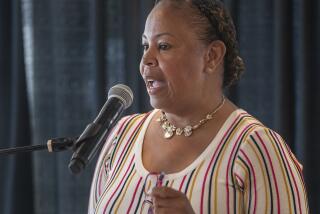Wieder Offers Own Master Growth Plan for Orange County
Supervisors Chairman Harriett M. Wieder proposed a comprehensive plan to manage the county’s future development Thursday, just three days after Supervisor Gaddi H. Vasquez said he was researching a similar master plan.
Wieder said that her plan is offered as a companion to Vasquez’s and that the two should be compared and, if appropriate, combined. She said it is not intended to replace or compete with Vasquez’s proposal.
The plans are similar in that both are designed to manage the county’s future development with the intent of reducing traffic congestion, identifying money for roads and public facilities and imposing caps on new construction.
The plans have been attacked by proponents of the Citizens’ Sensible Growth and Traffic Control Initiative, which is in its last days of a difficult signature-gathering effort to qualify for the June 7 ballot. The organizers said the supervisors are publicizing their plans now to circumvent the signature drive.
Wieder proposes that the county consider the growth management plan adopted by the Carlsbad City Council in 1986.
“This is managing the problem, it is not complaining about it,” Wieder said. “I’m going to ask the county staff to take a look at this. I don’t believe in reinventing the wheel.”
Vasquez said Thursday that his proposal is in its infancy and has room for change. He said he has not seen the Carlsbad plan proposed by Wieder.
Vasquez said of his plan, “I’m not proposing this as the all-encompassing solution. No one has an exclusive copyright or corner of the market on solutions in the county.
“This simply conditions future growth so that local government would be able to manage the needs of the infrastructure without taxing the residents of Orange County,” he said.
Both supervisors and county officials said they did not know how much longer the process of researching and preparing a management plan will take.
Next Tuesday is the deadline for gathering the 66,000 signatures needed to qualify the controlled-growth initiative for the ballot. Tom Rogers, one of the organizers, said about 15,000 signatures still are needed.
“The timing (of Vasquez’s proposal) tells me its sole intention is political,” Rogers said.
Vasquez said the supervisors could adopt his proposal as an ordinance or put the plan on the ballot to be evaluated by voters.
Gregory Hile, an attorney and author of the growth and traffic control initiative, said a ballot question from the supervisors would be perceived as competition with their measure.
“We always expected there would be an alternative measure,” he said.
Wieder said she would prefer that the supervisors pass the growth plan as an ordinance rather than place it on the ballot. If the supervisors believe that their plan is best for the county, they should pass it without going to the voters, she said.
“I don’t know if we should look like we’re competing with them,” Wieder said. “I think we have to show we have a responsibility.”
The supervisors’ plans apparently differ only subtly.
Under Vasquez’s proposal, the rate of the county’s annual growth would be capped at 1.9%. That rate is based on an average of the county’s growth rate over the last 10 years.
Since the economy has peaks and slow times, the cap would reduce the overall rate of growth in the county, officials said.
For example, in good economic times, the demand for development would exceed the cap. And conversely, in bad economic times, such as in 1981 and 1982, the rate of development was well below 1.9%.
Vasquez also proposed a financing mechanism for building public facilities like libraries and police and fire stations. It would be modeled after the county’s Foothill Circulation Phasing Plan, a five-year program to build $235 million in new roads that are completely funded by developers of nearby communities.
The Vasquez plan would also make provisions for park space, wildlife resources and child-care facilities.
The two plans are similar in that they divide the county to analyze the needs of each subsection, such as for roads, police and fire protection and commercial development.
The plan proposed by Wieder examines each section so that, in a way, each is self-sufficient.
For example, the amount of commercial development approved for a section would be determined, in part, by the tax revenue needed to offset the cost of public facilities in that section. Also, its objective would be to place employees closer to their workplaces, reducing the demand on the county’s highways.
The Carlsbad plan also limits housing units in each subsection, rather than requiring one cap for the entire county. Wieder said that provision is attractive because of differences between the northern and southern portions of Orange County.
More to Read
Sign up for Essential California
The most important California stories and recommendations in your inbox every morning.
You may occasionally receive promotional content from the Los Angeles Times.










